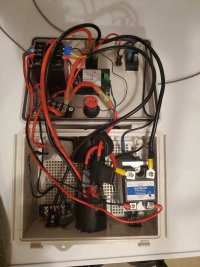beerisambrosia
Member
- Joined
- Sep 4, 2011
- Messages
- 18
- Reaction score
- 0
I'm looking for help with my wiring diagram for a controller. First off, some constraints. I have a 240V 14-50R outlet (4 wires) with a 50 amp GFCI breaker in the panel and an Inkbird PID controller. (I know, should've bought a PID that was built for brewing.) Due to the outlet and my desire to preserve the ability to drop a 120V plug in this or a future controller, I'm using a 14-50P to 14-30R adapter, then a 14-30P to 14-30R cord that'll go to the controller. The controller will have a panel mount L14-30R (male) receptacle so I don't have wires hanging out of the box. I'll be powering a 5500 W heating element (drawing 23 amps at 240V), so 10 AWG wire is used for 240V connections inside the box. In my schematic, I have 3 red rocker DPST switches for (1) the PID controller, (2) the L6-30R outlet to the heating element, and (3) the 5-15R outlet. I'm grounding outlets to the incoming ground wire. I've got a 60 amp SSR with heat sink. I don't think I'll have room for my 50 mm 5VDC fan and its power supply. At this point, I haven't added a 30 amp GFCI breaker or fuse(s). I'm not sure they're needed given I have the 50 amp breaker, though I think I won't be protected between 30 and 50 amps. If I installed a fuse, I'm not sure where it'd/they'd go. Would I need two 30 amp fuses, one at each hot wire entry to the box? Anyway, I'll stop here. Please take a look at the diagram. My box is roughly 4x6x8, which leave precious little room due to the two giant flush mounted receptacles. Thanks for taking a look.










